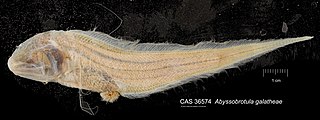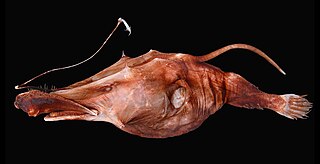
Leftvents are a family, the Linophrynidae, of marine ray-finned fishes which is classified within the suborder Ceratioidei, the deep sea anglerfishes. These fishes are found in the Atlantic, Indian and Pacific Oceans.

The sea toads and coffinfishes are a family, the Chaunacidae, of deep-sea ray-finned fishes belonging to the monotypic suborder Chaunacoidei within the order Lophiiformes, the anglerfishes. These are bottom-dwelling fishes found on the continental slopes of the Atlantic, Indian, and Pacific Oceans, at depths to at least 2,460 m (8,070 ft). There have also been findings of deep-sea anglerfishes off the coasts of Australia and New Caledonia. Other findings suggest some genera of Chaunacidae are found near volcanic slopes encrusted with manganese. Of the two genera in the family, Chaunacops are typically found at deeper depths than Chaunax, but with considerable overlap between the two genera.

Double anglers, the family Diceratiidae, is a small and little known family of rarely encountered marine ray-finned fishes belonging to the order Lophiiformes, the anglerfishes. The two genera and seven species of this family are found in the deeper waters of the tropical and subtropical Atlantic, Indian and Pacific Oceans. They are distinguished from other deep sea anglerfishes by the possession of a second bioluminescent cephalic spine. The fishes in this family were known only from metamorphosed females and the males were not described until 1983.
Thaumatichthyidae, the wolftrap anglers, is a small family of marine ray-finned fishes, also called the wolftrap seadevils, classified within the suborder Ceratioidei, the deep-sea anglerfishes. They have distinctive upper jaws with movable premaxillaries that can be lowered to form a cage-like trap around the much shorter lower jaw.

Ipnops is a genus of deep-sea fish in the family Ipnopidae, which also includes the better-known tripodfish. Ipnops are small, slender fish that live close to the ocean floor in the bathyal and abyssal zones. The genus is notable for its unusual eyes.

The horned lantern fish or prickly seadevil is a species of marine ray-finned fish, it is the only species in the monotypic family Centrophrynidae. This species has a circumglobal distribution and is distinguished from other deep-sea anglerfishes by various characters including four pectoral radials, an anterior spine on the subopercular bone, and a short hyoid (chin) barbel in both sexes.

The toothed seadevil, spiny seadevil or netbeard seadevil,, is a rarely seen deep-sea anglerfish found in the mesopelagic and bathypelagic zones in Oceans around the World. It is the only species in the family Neoceratidae, and is unique amongst the deep-sea anglerfish in lacking an illicium and esca, and in having large teeth placed on the outside of its jaws.

Abyssobrotula galatheae is a species of cusk eel in the family Ophidiidae. It is the deepest-living fish known; one specimen, trawled from a depth of 8,370 m (27,460 ft) in the Puerto Rico Trench in 1970, holds the record for the deepest fish ever captured. Although generally recognized, some have suggested that the record-breaking individual might have been caught with a non-closing net and therefore perhaps caught shallower.

Thaumatichthys, the wonderfish, is a genus of deep-sea anglerfish in the family Thaumatichthyidae, with three known species. Its scientific name means "wonder-fish" in Greek; oceanographer Anton Bruun described these fishes as "altogether one of the oddest creatures in the teeming variety of the fish world." In contrast to other anglerfishes, the bioluminescent lure of Thaumatichthys is located inside its cavernous mouth. They are worldwide in distribution and are ambush predators living near the ocean floor.

The complete anglerfish (Lasiognathus) is a genus of deep-sea anglerfish in the family Thaumatichthyidae, with six species known from the Atlantic and Pacific Oceans. Its lure apparatus appears to consist of a fishing rod, a fishing line, bait, and hooks. It is also distinctive for an enormous upper jaw with premaxillaries that can be folded down to enclose the much shorter lower jaw.

The anglerfish are fish of the teleost order Lophiiformes. They are bony fish named for their characteristic mode of predation, in which a modified luminescent fin ray acts as a lure for other fish. The luminescence comes from symbiotic bacteria, which are thought to be acquired from seawater, that dwell in and around the sea.

Black seadevils are small, deepsea lophiiform fishes of the family Melanocetidae. The five known species are all within the genus Melanocetus. They are found in tropical to temperate waters of the Atlantic, Indian, and Pacific Oceans, with one species known only from the Ross Sea.

The humpback anglerfish is a species of black seadevil in the family of Melanocetidae, which means "black whale" in Greek. The species is named after James Yate Johnson, the English naturalist who discovered the first specimen in Madeira in 1863. The common names include anglerfish, viperfish and fangtoothfish.

The Galathea expeditions comprise a series of three Danish ship-based scientific research expeditions in the 19th, 20th and 21st centuries, carried out with material assistance from the Royal Danish Navy and, with regard to the second and third expeditions, under the auspices of the Danish Expedition Foundation. All three expeditions circumnavigated the world from west to east and followed similar routes.
The Emden Deep, also known as the Galathea Deep or Galathea Depth, is the portion of the 10,540-metre-deep (34,580 ft) Philippine Trench exceeding 6,000-metre (20,000 ft) depths in the south-western Pacific Ocean.
Teuthidodrilus samae, dubbed as the squidworm, is a species of acrocirrid marine annelid worms. It is free-swimming and can be found in the deep sea water column at depths of 2,039 to 2,912 m. It feeds on marine snow and can grow to about 9 cm (3.5 in) in length and 1 cm (0.39 in) in width. It is named for the ten squid-like appendages emerging from its head. It was discovered in 2007 in the benthopelagic zone of the Celebes Sea, near the Tawi-Tawi islands of the Philippines. It is the only species in the genus Teuthidodrilus.

Puck pinnata, the mischievous dreamer, is a species of marine ray-finned fish belonging to the family Oneirodidae, the dreamers, a family of deep-sea anglerfishes. This species is known from four metamorphosed female specimens each collected from four separate locations, three in the Pacific Ocean and one in the Atlantic Ocean. As with all other species in the family, it is a pelagic, deep-water fish that is a member of the abyssal ecosystem. It is the only known species in the monospecific genus Puck.

Melanocetus murrayi, commonly known as Murray's abyssal anglerfish, is a deep sea anglerfish in the family Melanocetidae, found in tropical to temperate parts of the world's oceans at depths down to over 2,000 m (6,600 ft). Its length is up to 13.5 cm (5 in) for females and up to 2.8 cm (1.1 in) for males.

Ipnops meadi, also known as the grideye fish, is a highly specialized species of Placodithyran abyssal fish found in the Clarion-Clipperton Zone of the Indo-Pacific Ocean. The species was named after Giles W. Mead of the Harvard Museum of Comparative Zoology, a biology professor at Harvard, deep sea explorer, and ichthyologist.

Halieutopsis galatea, the Galathea deepsea batfish, is a species of ray-finned fish belonging to the family Ogcocephalidae, the deep sea batfishes. This fish is found in the Indian Ocean.














